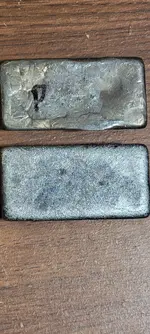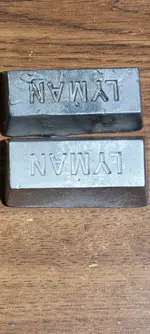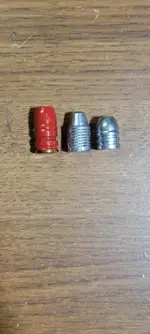Perfect....thanks.....I've cast 1,000's of .44's (the actual diameter is .430, I guess ".43 magnum" doesn't sound as cool as ".44 magnum"), and in my unprofessional opinion I think it's safe to say your bullets have had an alloy added to them and are not pure lead. I've attached pictures of a pure lead ingot and an ingot that has had about 7% antimony added to it, to make the lead harder..notice how much "grainier" the ingot looks on the bottom of the alloy ingot...many reasons for hardening pure lead now a days, the main reason is to cut down on lead fowling in the barrel....pure lead through a barrel after 3 to 5 shots, accuracy degrades tremendously and barrel pressures spike to unsafe levels....not a huge deal back in the mid to late 1800's when black powder was used but todays powders (propellants) burn at a much faster rate resulting in much higher pressures.....when casting bullets with an alloy, (usually antimony and or tin, tin is actually used more to help the lead "flow or fill" the mold more completely but does provide some extra hardness) the alloy is always lighter than the lead which results in the alloy floating to the top, as seen in your bullet base and on the base of my alloy lead ingot , when they are cooling. I powder coat my lead / alloy cast bullets and get zero lead fowling in my rifles. My best guess is your bullets are more modern because of the grainy texture on the base....just a guess though....only way to know for sure is to cut one, which you do not want to do...pure lead you could cut with one hand....alloy added...2 hands would be needed. BTW...awsome find on that pile of minnies...I guess someone's ammo pouch fell
off their horse....banner find in my eyes
View attachment 2058839View attachment 2058840View attachment 2058841









